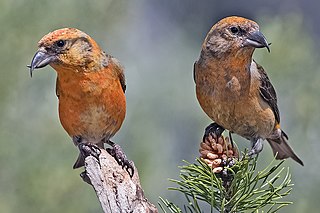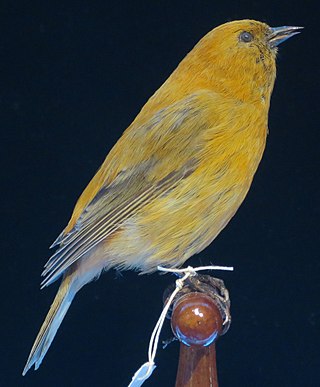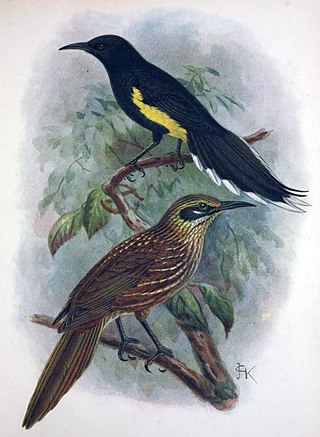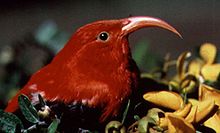Taxonomy
Before the introduction of molecular phylogenetic techniques, the relationship of the Hawaiian honeycreepers to other bird species was controversial. The honeycreepers were sometimes categorized as a family Drepanididae, [3] other authorities considered them a subfamily, Drepanidinae, of Fringillidae, the finch family. The entire group was also called Drepanidini in treatments where buntings and American sparrows (Passerellidae) were included in the finch family; this term is preferred for just one subgroup of the birds today. [4] [5] Most recently, the entire group has been subsumed into the finch subfamily Carduelinae. [2] [6]
The Hawaiian honeycreepers are the sister taxon to the Carpodacus rosefinches. Their ancestors are thought to have been from Asia and diverged from Carpodacus about 7.2 million years ago, and they are thought to have first arrived and radiated on the Hawaiian Islands between 5.7-7.2 million years ago, which was roughly the same time that the islands of Ni'ihau and Kauai formed. The lineage of the recently extinct po'ouli (Melamprosops) was the most ancient of the Hawaiian honeycreeper lineages to survive to recent times, diverging about 5.7-5.8 million years ago. The lineage containing Oreomystis and Paroreomyza was the second to diverge, diverging about a million years after the po'ouli's lineage. Most of the other lineages with highly distinctive morphologies are thought to have originated in the mid-late Pliocene, after the formation of Oahu but prior to the formation of Maui. Due to this, Oahu likely played a key role in the formation of diverse morphologies among honeycreepers, allowing for cycles of colonization and speciation between Kauai and Oahu. [7]
A phylogenetic tree of the recent Hawaiian honeycreeper lineages is shown here. Genera or clades with question marks (?) are of controversial or uncertain taxonomic placement. [7] [8]
The classification of Paroreomyza and Oreomystis as sister genera and forming the second most basal group is based on genetic and molecular evidence, and has been affirmed by numerous studies; however, when morphological evidence only is used, Paroreomyza is instead the second most basal genus, with Oreomystis being the third most basal genus and more closely allied with the derived Hawaiian honeycreepers, as Oreomystis shares traits with the derived honeycreepers, such as a squared-off tongue and a distinct musty odor, that Paroreomyza does not. This does not align with the genetic evidence supporting Paroreomyza and Oreomystis as sister genera, and it would be seemingly impossible for only Paroreomyza to have lost the distinctive traits but Oreomystis and all core honeycreepers to have retained or convergently evolved them, thus presenting a taxonomic conundrum. [8]
Viridonia (containing the greater ʻamakihi) may be associated with or even synonymous with the genus Aidemedia (containing the prehistoric icterid-like and sickle-billed gapers), and has the most debated taxonomy; it was long classified within the "greater Hemignathus" radiation (a now-paraphyletic grouping containing species formerly lumped within Hemignathus, including Hemignathus, Akialoa, and Chlorodrepanis ) and while some sources speculate it as being sister to Chlorodrepanis (containing the lesser ʻamakihis), other sources speculate it may be a sister genus to the genus Loxops (containing the 'akepas, ʻakekeʻe and ʻalawī). [8]
Characteristics
Nearly all species of Hawaiian honeycreepers have been noted as having a unique odor to their plumage, described by many researchers as "rather like that of old canvas tents". [9] [10]
Today, the flowers of the native ʻōhiʻa ( Metrosideros polymorpha ) are favored by a number of nectarivorous honeycreepers. The wide range of bill shapes in this group, from thick, finch-like bills to slender, down-curved bills for probing flowers have arisen through adaptive radiation, where an ancestral finch has evolved to fill a large number of ecological niches. Some 20 species of Hawaiian honeycreeper have become extinct in the recent past, and many more in earlier times, following the arrival of humans who introduced non-native animals (ex: rats, pigs, goats, cows) and converted habitat for agriculture. [11] [12]

The true finches are small to medium-sized passerine birds in the family Fringillidae. Finches generally have stout conical bills adapted for eating seeds and nuts and often have colourful plumage. They occupy a great range of habitats where they are usually resident and do not migrate. They have a worldwide native distribution except for Australia and the polar regions. The family Fringillidae contains more than two hundred species divided into fifty genera. It includes the canaries, siskins, redpolls, serins, grosbeaks and euphonias, as well as the morphologically divergent Hawaiian honeycreepers.
Located about 2300 miles (3680 km) from the nearest continental shore, the Hawaiian Islands are the most isolated group of islands on the planet. The plant and animal life of the Hawaiian archipelago is the result of early, very infrequent colonizations of arriving species and the slow evolution of those species—in isolation from the rest of the world's flora and fauna—over a period of at least 5 million years. As a consequence, Hawai'i is home to a large number of endemic species. The radiation of species described by Charles Darwin in the Galapagos Islands which was critical to the formulation of his theory of evolution is far exceeded in the more isolated Hawaiian Islands.

The cardueline finches are a subfamily, Carduelinae, one of three subfamilies of the finch family Fringillidae, the others being the Fringillinae and the Euphoniinae. The Hawaiian honeycreepers are now included in this subfamily. Except for the Hawaiian honeycreepers which underwent adaptive radiation in Hawaii and have evolved a broad range of diets, cardueline finches are specialised seed eaters, and unlike most passerine birds, they feed their young mostly on seeds, which are regurgitated. Besides this, they differ from the other finches in some minor details of their skull. They are adept at opening seeds and clinging to stems, unlike other granivorous birds, such as sparrows and buntings, which feed mostly on fallen seeds. Some members of this subfamily are further specialised to feed on a particular type of seed, such as cones in the case of crossbills. Carduelines forage in flocks throughout the year, rather than keeping territories, and males defend their females rather than a territory or nest.

Akialoa is an extinct genus of Hawaiian honeycreeper in the subfamily Carduelinae of the family Fringillidae. The ʻakialoa species are all extinct, but they formerly occurred throughout Hawaii.

Ciridops is an extinct genus of Hawaiian honeycreeper species that occurred in prehistoric and historic times on the Hawaiian islands of Hawaii, Molokai, Kauai and Oahu. This genus was created in 1892 by Alfred Newton in an article published by the journal Nature on the basis of the ʻula-ʻai-hawane, which was named Fringilla anna by Sanford B. Dole in 1879.

The Oʻahu ʻamakihi is a species of Hawaiian honeycreeper in the family Fringillidae. The male is rich yellow below, sharply contrasted with greenish upper parts. Females are duller and have two prominent wing-bars. It has a total length of approximately 4.5 inches (11 cm). It is endemic to the island of Oʻahu in Hawaiʻi, and is likely the only surviving honeycreeper endemic to the island.

The Hawaiʻi ʻamakihi, also known as the common ʻamakihi, is a species of Hawaiian honeycreeper.

Loxops is a Hawaiian honeycreeper genus in the finch family, Fringillidae. Most of them are commonly known as ʻakepa.

Paroreomyza is a genus of Hawaiian honeycreeper in the subfamily Carduelinae of the family Fringillidae. These birds are endemic to Hawaii.

The Oʻahu ʻalauahio, also known as the Oʻahu creeper, is a small finch-like Hawaiian honeycreeper that is endemic to the Hawaiian island of Oahu. It is Critically endangered.

The Maui ʻalauahio, also known as the Maui Nui ʻalauahio or Maui creeper, is a species of Hawaiian honeycreeper. It is endemic to Maui Nui, Hawaii. The name Maui ʻalauahio is somewhat misleading because the species seems to have occurred on most, if not all, parts of the ancient Maui Nui, which includes the present day islands of Maui, Molokaʻi, Lānaʻi, and Kahoʻolawe. There are two subspecies: the Lānaʻi ʻalauahio, P. montana montana, which occurred on Lānaʻi (extinct); and P. montana newtoni which occurs on Maui. The common name refers to both groups.

The lesser koa finch is an extinct species of Hawaiian honeycreeper in the subfamily Carduelinae of the family Fringillidae. It was endemic to the island of Hawaiʻi.

Rhodacanthis, commonly known as the koa finches, is an extinct genus of Hawaiian honeycreeper in the subfamily Carduelinae of the family Fringillidae. All four species were endemic to Hawaii.
The giant nukupuʻu is an extinct species of finch in the family Fringillidae, which is only known from fossil remains. It was endemic to Hawaii. Its extinction is believed to have occurred within the last 3000 years, but exact timing and reasons remain unclear. It was larger and had a different bill morphology than the remaining members of the genus Hemignathus.

Mohoidae, also known as the Hawaiian honeyeaters, was a family of Hawaiian species of now recently extinct, nectarivorous songbirds in the genera Moho (ʻōʻō) and Chaetoptila (kioea). These now extinct birds form their own family, representing the only complete extinction of an entire avian family in modern times, when the disputed family Turnagridae is regarded as invalid. The last surviving species in the family, the Kauai O'o, became extinct after 1987.
This page is based on this
Wikipedia article Text is available under the
CC BY-SA 4.0 license; additional terms may apply.
Images, videos and audio are available under their respective licenses.














